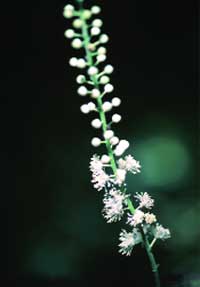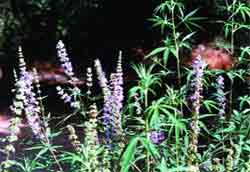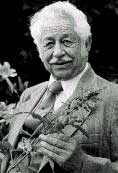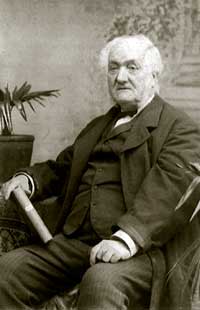Positive Health Online
Your Country

The Incredible Journey of Herbal Medicine
by Jill Rosemary Davies(more info)
listed in herbal medicine, originally published in issue 65 - June 2001
Having survived hard times, herbal medicine has returned from the brink.
In 1941 the British government formally dissolved the practice of herbal medicine. By 1947, herbalists who were still working, albeit illegally, were asked if they would like to join the NHS as an 'auxiliary' to the medical profession. Pride and knowledge firmly in hand, they turned down the 'offer'. Thus herbal medicine remained illegal until 1968 when under Sections 12 and 56 of the Medicines Act, herbalists were given back the right to practise.
The Renaissance of Herbs for the Menopause
Herbs are becoming commonplace features of life in Britain, and with a range of manifestos in place to support research, safety, training programmes and more, it looks to become a steadfast and mainstream therapy for decades to come. Herbs can treat almost any condition or disease, never mind providing help to prevent their onset. Take for instance the menopause; through education this natural phase in a woman's life can be passed through much more smoothly if small doses of appropriate herbs are taken early on or indeed larger doses during the peak of the menopause. Some 80% of women aged between 37 and 57 years experience a normal menopause that includes some of the regular menopausal side effects. The other 20% are split into two categories, with 10% having almost no symptoms while the other 10% have extreme symptoms and other health breakdowns. The average 80% can experience irritability, poor concentration, tension, anxiety and depression, through to the physical symptoms of headaches, heart palpitations, disturbed sleep, hot flushes, night and day sweats, dizziness, drying of the skin and vaginal secretions – and for some the onset of osteoporosis as oestrogen levels dwindle.
My whole outlook and work are related to the natural management of the menopause, not being in favour with the majority of drugs. I have listened to many women who experience bad side effects with HRT (including weight gain, depression, palpitations – the list can be endless). For other women it has been a wonder drug, transforming what might have been an ordeal for many women who received no help. The incredible thing about the return and availability of herbs over the last decade is that they have helped thousands of women through the menopause, who take the appropriate herbs and foods to support calcium levels, and also hormone supportives and tonics which can maintain and balance the whole body, not least the loss of oestrogen.

Black Cohosh: Actaea racemosa in flower. Photo courtesy Steven Foster
Plants such as black cohosh and agnus castus alongside many others have helped to transform the menopause for thousands of women. These particular plants hail from two completely different lineages of herbal medicine and geographic location. Black cohosh (Actaea racemosa) is indigenous to the mid-south in the USA and was used originally by the local native Indian tribes of the area and beyond, and was introduced to Britain via the settlers. Due to over-harvesting in the wild, black cohosh is now commercially produced on a large scale in Germany and to a smaller extent in Britain and other countries. Agnus castus (Vitex agnus castus) can be found growing wild all over Greece, Crete and other similar European climates and was a plant used by the great ancient Greek herbalists. It eventually found its way to the hospices of medieval British monks and was known as monk's pepper because of its rather peppery taste and reputation as an aphrodisiac!

Agnus Castus: Vitex agnus castus, flowering in Crete with some green
immature seeds already visible. Photo: Jill Rosemary Davies
Agnus castus affects the menopause in many positive ways, mainly by gearing production of deficit hormones (oestrogen and progesterone alike) through dialogue with the pituitary and hypothalamus glands. When a menopausal hot flush occurs it is because the hypothalamus, and then the pituitary gland, is registering a drop in oestrogen levels. As the hypothalamus is partly responsible for controlling body temperature, a by-product of this trigger effect is to release massive amounts of adrenaline and subsequently raise the body's temperature. The adrenaline rush is its attempt to rush around and find any available oestrogen. Should there be no oestrogen, then the hot flushes will continue to come and go. Hormone balancing herbs like agnus castus (and see below black cohosh and others) help here as they provide the missing hormones, thus over time letting the body know that hot flushes are not necessary. Black cohosh not only provides oestrogen, but also nourishes the nerves and generally relaxes the body. Its biochemistry includes many components, for instance the triterpene glycosides such as acetin and cimicifugoside, which are partly responsible for the reduction in luteinizing hormones. This in turn brings relief to many of the uncomfortable symptoms and helps to prevent bone density loss by negotiating with the hypothalamic and pituitary system. One of the very interesting aspects of black cohosh and oestrogen production is caused by oestrogenic isoflavones, which can be selective (known as 'selective oestrogen receptor modulators' or SERMS). These can be switched on and off giving a supply of oestrogen, wholly or partially, which makes it potentially safe to use with women who may have oestrogen-dependent cancers and who are also in the menopause. Other compounds within black cohosh include salicylic acid (which is part of the aromatic phenolic ring compound), which assists in balancing prostaglandin influences, thus supporting inflammation and pain reduction via their 'anti-heat' (hot flushes) abilities. All in all the many other useful biochemicals work as a group to reduce hot flushes and various other symptoms.

Dr John Christopher: The famous American herbalist 'elder ', who taught
thousands the art and science of herbal medicine and natural healing.
Other herbs to assist the menopause might include sage (Salvia officinalis), which is rich in hormonal balancing components and has an ability to calm fierce sweating. Valerian (Valeriana officinalis) is classically used to calm anxious states and can be invaluable for periods of anguish or insomnia.
Similarly St John's wort can be used for depression and other nerve-related symptoms. St John's wort has been at the heart of the British government's urgency to 'sort out' herbal medicine; more on this later. The list could go on and on, to include hawthorn to protect the heart, stabilize palpitations and strengthen blood vessels, which can all be under pressure with severe hot flushes. Formulas are available for sale 'over the counter' and can often suit the majority of women. Those who require more professional assistance should consult a qualified herbalist who can create a unique formula to suit. For instance some women need more adrenal support than others and then adrenaline 'food' in the form of herbs like Siberian ginseng (Eleutherococcus senticosus) with tiny amounts of liquorice will help. Herbal practitioners almost exclusively use tinctures and extracts, which are liquid concentrations of herbs, and quite rightly they feel these produce some of the best results. They favour them (alongside herbal teas) because 'tasting' the herb is a vital part of the holistic approach. Tasting means that many digestive enzymes are motivated and this increased digestive well-being will in turn hugely assist many other organs and systems, as a vital by-product. Where possible organic and freshly harvested herbs are sought and used.
Drugs very often exist to treat a range of conditions but for a range of reasons members of the public are increasingly turning to alternative medicine and, according to a recent survey undertaken by the BBC, herbal medicine is the one most frequently turned to for help. The vast majority of this herbal help comes through 'over-the-counter' sales, while the rest is provided by professional herbal practitioners. There are approximately 1,000 herbalists in practice today and, because herbalists have been in a 'backwater' for well over 100 years, their numbers at present reflect the past political situation. If we look back into the past of herbal medicine it will be easy to see just why so few herbal medicine professionals exist; however in the future this trend is set to change.
The History of Herbal Medicine

Ezra Suggett, my great great grandfather who was
practising during the troubled times of the mid 1860s.
In Britain during the mid-1860s trouble was looming for the country's apothecaries, also called 'medical botanists' into the 1900s. Realizing that the doctors and surgeons of Britain were keen to 'see them gone' they formed themselves into what is now the oldest herbal organization still to exist: the National Institute of Medical Herbalists (NIMH). This kept the profession going in an organized group, which included my great-great-grandfather who was an apothecary in Beccles, Suffolk and Islington, London, over some 50 years. Yet in 1941 the British government formally dissolved the practice of herbal medicine. By 1947, herbalists who were still working, albeit illegally, were asked if they would like to join the NHS as an 'auxiliary' to the medical profession. Pride and knowledge firmly in hand, they turned down the 'offer'. Thus herbal medicine remained illegal until 1968 when under Sections 12 and 56 of the Medicines Act, herbalists were given back the right to practise. From then on a small trickle of herbalists were trained, there being only 'dozens' by 1974. But the 1970s saw a huge resurgence in interest and the then existing small group swelled in the ensuing 20 years – hence the 1,000 or so trained practitioners mentioned above. This was all achieved by the wisdom and leadership of a handful of herbalist elders who strived to teach and pass on the knowledge in trying times. During this time the British Herbal Medical Association (BHMA) supported the herbal industry, helping to regulate and protect the sales of herbs as it still does. Now the BHMA is a major force in regulating the over-the-counter sale of herbs. The boat started to rock again, however, by the early 1990s, and in 1993 it was understood that many herbs could no longer be legally classified as 'foods', as they were clearly medicines. In addition, it became clear that the public would need some way to recognize trained herbalists. To this end an umbrella organization, The European Herbal Practitioners Association (EHPA), was formed, which turned out to be a vital initiative as by 1994 all herbal medicines were threatened by new EU legislation because they could not qualify for full medicines licences like conventional drugs. The EHPA saw the coming together of several herbal medicine associations, not least the oldest one, the NIMH.
By the end of 1994, after an extraordinary show of public support for herbal medicine (MPs and Ministers were deluged with outraged letters about the imminent demise of herbal medicine), the then health minister Virginia Bottomley and the Prime Minister John Major agreed to rescue herbal medicine. During a never to be forgotten weekend, government lawyers brought herbal medicine back from the brink, agreeing that it had traditional status and was therefore not technically subject to EU medicines licensing requirements.
Since then, the EHPA and BHMA have been working with the Medicines Control Agency (MCA) and the European Commission to bring in new and appropriate regulations for herbal medicine so as to provide the public with quality assured herbal medicines. In addition, the EHPA has been negotiating with the Department of Health to secure state registration for herbal practitioners. This has involved a huge amount of work to agree a common training programme as well as codes of ethics and disciplinary measures, so that it can be clearly demonstrated to the public that they are in safe hands and will receive high quality herbal treatment. It is planned that registration will cover Ayurvedic, Western, Chinese, Japanese and other herbal traditions.
Research with Herbal Medicines
There are also plans to divert some of the vast funds currently designated for research into orthodox medicine to research herbal treatments. There remains, however, a concern amongst herbal practitioners. Most research done over the past decade or so on herbal medicine involves the use of standardized extracts which are selected and mostly single biochemical components deemed to be the 'active' constituent(s). The rest are discarded.
These chosen 'extracts' are very concentrated doses and are extracted using chemicals, which, with the best will in the world, leave small residues once the process is completed. These standardized extracts are somewhere between a drug and a herb and tend to be viewed as useful in minority situations where extreme conditions are presenting. For example, in 1981 Dr Vogel of the University of Munich, Germany, treated patients who had been poisoned by the death cap mushroom. Daily injections of Silymarin reduced the death rate to zero, whereas the expected rate is normally 30% to 40%. To highlight what I mean about research and extracts it will be useful to draw upon a piece of research published recently in the British Medical Journal.[1] The conclusion of the study was that the "dry extract of agnus castus fruit is an effective and well tolerated treatment for the relief of symptoms of the premenstrual syndrome". In the article it would appear from the literature given that a flavonoid called casticin was the chosen biochemical component for use. Our old friend of this article, agnus castus, was the plant from which this component was extracted. Agnus castus contains many biochemicals, mainly flavonoids and iridoid glycosides, which don't appear to have been included – such as acubin, agnoside, eurostoside and diterpenes, which are renowned for their ability to alter favourably and balance prolactin effects. (If these biochemicals were included in the standardization then the literature didn't say so). It must be understood that an active isolated chemical extract is not the same as the whole plant, and enhancing one aspect of a plant does not work either since the exact mode of action of plants has not yet been discovered. Certainly two plants both extensively researched, for example garlic and St John's wort, still remain enigmas. It is still not fully understood how they work! Agnus castus is not alone in containing multiple constituents, someactive and some inactive, some known and some unknown compounds; some understood and some still non-understood mechanisms of activity, as in the case of St John's wort which is widely used and deemed largely safe for the majority of people. A challenge for those in favour of 'standardization' is the variability within each plant of these various compounds, giving rise to the non-measurability and consistency argument. This is all part of herbalism according to herbal practitioners. Practitioners also use formulas, which are more commonly employed than single herbs although single herbs are of course frequently used as well. Formulas contain five or more herbs, and these multiple herb formulas containing multiple compounds are the mainstay of all herbal traditions as they provide supportive effects covering a diversity of needs for a range of conditions. Let's hope research encompasses all this as well.
There is so much to do and yet finally so much optimism today for herbs and herbalism. "The future looks rosy" according to Michael Macintyre the chairman (and founder) of the EHPA. The past has been so incredibly stony it is good to enjoy this special moment in time. The incredible journey of herbal medicine continues.
Reference
1. Schellenberg R. Treatment for the Premenstrual Syndrome with Agnus Castus Fruit Extract: Prospective, Randomized Placebo Controlled Study. British Medical Journal. 322: 134-37. January. 2001. (Available on the BMJ website at www.bmj.com)
Further Reading
McQuade Crawford Amanda. The Herbal Menopause Book: Herbs, Nutrition and Other Natural Therapies. Crossing Press. Freedom. California. ISBN 0-89594-799-4. 1996.
Fox William. Botanic Guide to Health. William Fox & Sons (Sheffield) Ltd. Medical Botanists. 94 London Road. 1941.
Gladstar Rosemary. Herbal Healing for Women: Simple Home Remedies for Women of All Ages. Simon & Schuster. New York. ISBN 0-671-76767-4. 1993.
Rogers Carol. The Woman's Guide to Herbal Medicine. Hamish Hamilton. London. ISBN 0-241-13347-5. 1995.
Comments:
-
No Article Comments available